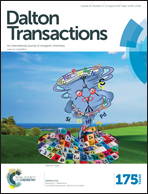Design and synthesis of novel organometallic dyes for NiO sensitization and photo-electrochemical applications†
Abstract
Two metallo-organic dyes were synthesized and used for NiO sensitization in view of their photoelectrochemical applications. The new dyes present an original π-conjugated structure containing the [Ru(dppe)2] metal fragment with a highly delocalized allenylidene ligand on one side and a σ-alkynyl ligand bearing an electron-rich group, i.e. a thiophene or triphenylamine unit, and one or two anchoring functions on the other side. The optoelectronic, electrochemical and photoelectrochemical properties of the dyes were systematically investigated. A broad photoresponse was observed with the absorption maximum at 600 nm. The X-ray crystal structure of one precursor was obtained to elucidate the structural conformation of the organometallic complexes and theoretical calculations were performed in order to address the photophysical properties of the new dyes. These photosensitizers were further implemented in NiO-based photocathodes and tested as photocurrent generators under pertinent aqueous conditions in association with [Co(NH3)5Cl]Cl2 as an irreversible electron acceptor. The dye-sensitized photocathodes provided good photocurrent densities (40 to 60 μA cm−2) at neutral pH in phosphate buffer and a high stability was observed for the two dyes.


 Please wait while we load your content...
Please wait while we load your content...